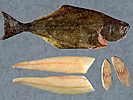|
|
 |
 |
Halibut :: Pacific Halibut
(Hippoglossus stenolepis)
Click on the images to enlarge |
Common names: Pacific halibut, halibut. Regional names: Alaska
halibut, common halibut, whitesided paltus.
Identification: Recognized by the slightly forked tail, the
sturdy body, the moderately large, almost symmetrical mouth with conical teeth,
arched lateral line and numerous smooth scales. Color is dark brown to gray
marbled on eyed side. Normally white on blind side.
Range: Southern California to the Bering Sea as far as Norton
Sound and St. Lawrence Island.
Season and Catch Methods: Alaska season currently two or three
24 hours fishing periods per year, usually in May-June, September and October.
Caught by longline.
Size: Range from 10 to 500+ lbs, average 35 to 50 lbs.
Product forms: Fresh: dressed/headed; fletches, skin-on or
skin-off; steaks and loins; cheeks. Frozen: dressed/headed; fletches, skin-on
or skin-off; steaks and loins; cheeks. Dressed headed fish typically graded:
10-20 lbs, 20-40 lbs, 40-60 lbs, 60-80 lbs, 80 lbs up. Steaks, fillets and
loins are typically graded: 4-, 6-, 8- and 10 ounce portions. Fletches
typically graded: 8-12 lbs.
Packaging: Larger fish glazed, smaller fish glazed and boxed
in 100 to 150 lb cartons. Steaks, fillets and loins can be individually vacuum
packed in 10 to 20 lb cartons. IQF fletches glazed and bagged in 50 lb cartons.
Cheeks frozen in 5 lb blocks.
Nutritional Value (3.5 oz (100 g) raw fillet): 110 Kcal, 20.7
Kcal from Fat, 21 g Protein, 2.5 g Total Fat, 0.3 g Saturated Fat, 0.4 g
Omega-3 Fat, 32 mg Cholesterol, 54 mg Sodium.
|
|



